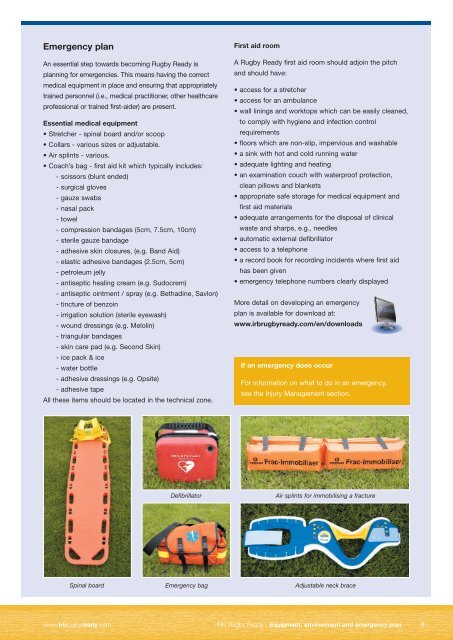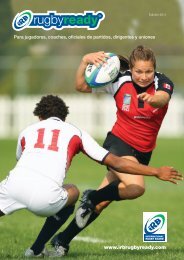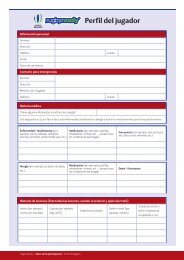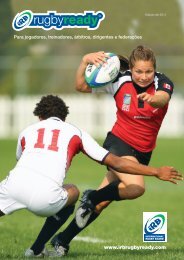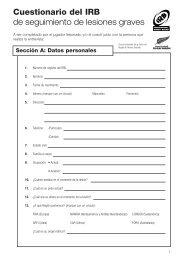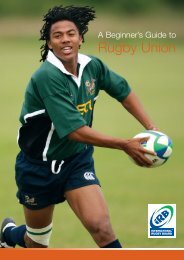IRB Beginner's Guide to Rugby - IRB Rugby Ready
IRB Beginner's Guide to Rugby - IRB Rugby Ready
IRB Beginner's Guide to Rugby - IRB Rugby Ready
Create successful ePaper yourself
Turn your PDF publications into a flip-book with our unique Google optimized e-Paper software.
Emergency plan<br />
An essential step <strong>to</strong>wards becoming <strong>Rugby</strong> <strong>Ready</strong> is<br />
planning for emergencies. This means having the correct<br />
medical equipment in place and ensuring that appropriately<br />
trained personnel (i.e., medical practitioner, other healthcare<br />
professional or trained first-aider) are present.<br />
Essential medical equipment<br />
• Stretcher - spinal board and/or scoop<br />
• Collars - various sizes or adjustable.<br />
• Air splints - various.<br />
• Coach’s bag - first aid kit which typically includes:<br />
- scissors (blunt ended)<br />
- surgical gloves<br />
- gauze swabs<br />
- nasal pack<br />
- <strong>to</strong>wel<br />
- compression bandages (5cm, 7.5cm, 10cm)<br />
- sterile gauze bandage<br />
- adhesive skin closures, (e.g. Band Aid)<br />
- elastic adhesive bandages (2.5cm, 5cm)<br />
- petroleum jelly<br />
- antiseptic healing cream (e.g. Sudocrem)<br />
- antiseptic ointment / spray (e.g. Bethadine, Savlon)<br />
- tincture of benzoin<br />
- irrigation solution (sterile eyewash)<br />
- wound dressings (e.g. Melolin)<br />
- triangular bandages<br />
- skin care pad (e.g. Second Skin)<br />
- ice pack & ice<br />
- water bottle<br />
- adhesive dressings (e.g. Opsite)<br />
- adhesive tape<br />
All these items should be located in the technical zone.<br />
First aid room<br />
A <strong>Rugby</strong> <strong>Ready</strong> first aid room should adjoin the pitch<br />
and should have:<br />
• access for a stretcher<br />
• access for an ambulance<br />
• wall linings and work<strong>to</strong>ps which can be easily cleaned,<br />
<strong>to</strong> comply with hygiene and infection control<br />
requirements<br />
• floors which are non-slip, impervious and washable<br />
• a sink with hot and cold running water<br />
• adequate lighting and heating<br />
• an examination couch with waterproof protection,<br />
clean pillows and blankets<br />
• appropriate safe s<strong>to</strong>rage for medical equipment and<br />
first aid materials<br />
• adequate arrangements for the disposal of clinical<br />
waste and sharps, e.g., needles<br />
• au<strong>to</strong>matic external defibrilla<strong>to</strong>r<br />
• access <strong>to</strong> a telephone<br />
• a record book for recording incidents where first aid<br />
has been given<br />
• emergency telephone numbers clearly displayed<br />
More detail on developing an emergency<br />
plan is available for download at:<br />
www.irbrugbyready.com/en/downloads<br />
If an emergency does occur<br />
For information on what <strong>to</strong> do in an emergency,<br />
see the Injury Management section.<br />
Defibrilla<strong>to</strong>r<br />
Air splints for immobilising a fracture<br />
Spinal board Emergency bag Adjustable neck brace<br />
www.irbrugbyready.com<br />
<strong>IRB</strong> <strong>Rugby</strong> <strong>Ready</strong> / Equipment, environment and emergency plan<br />
9


